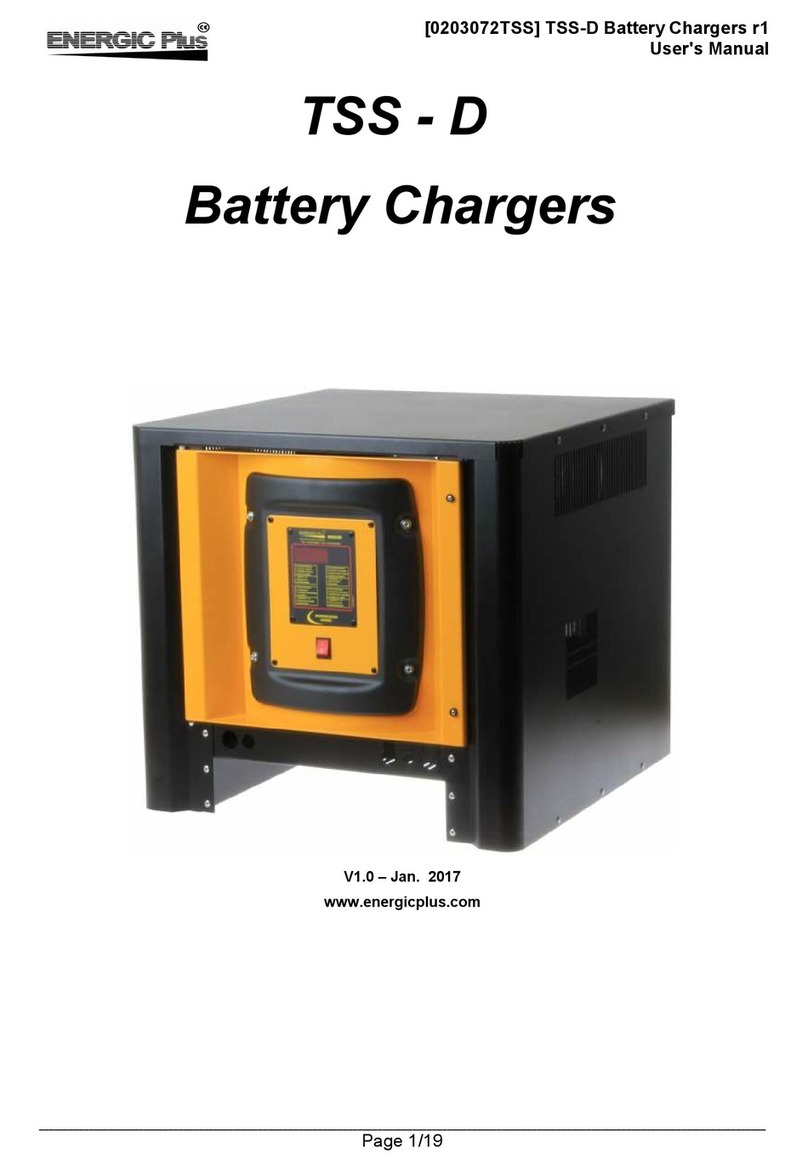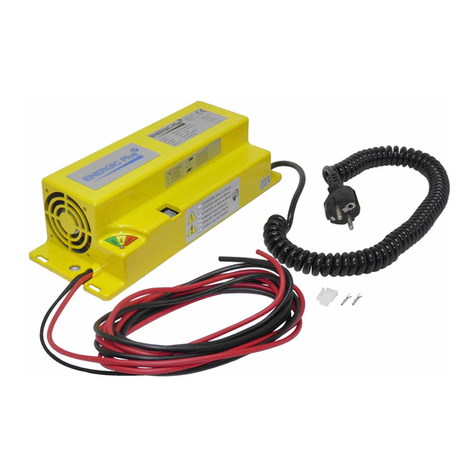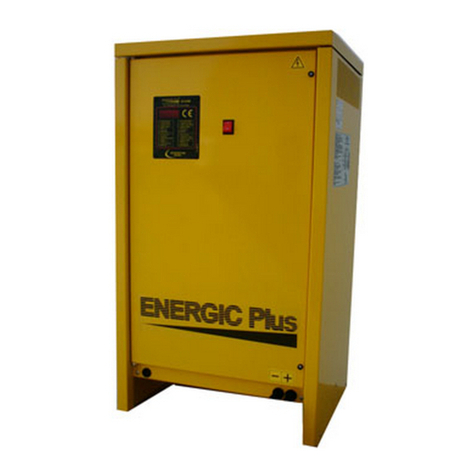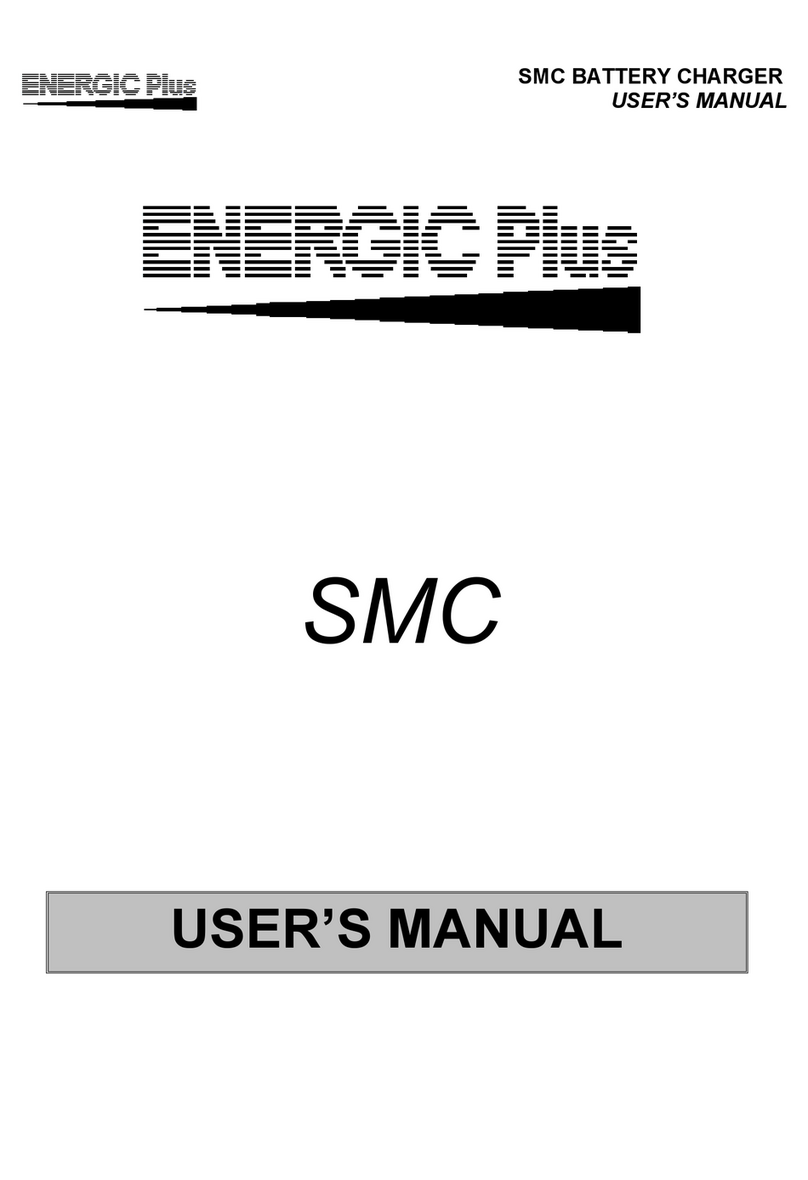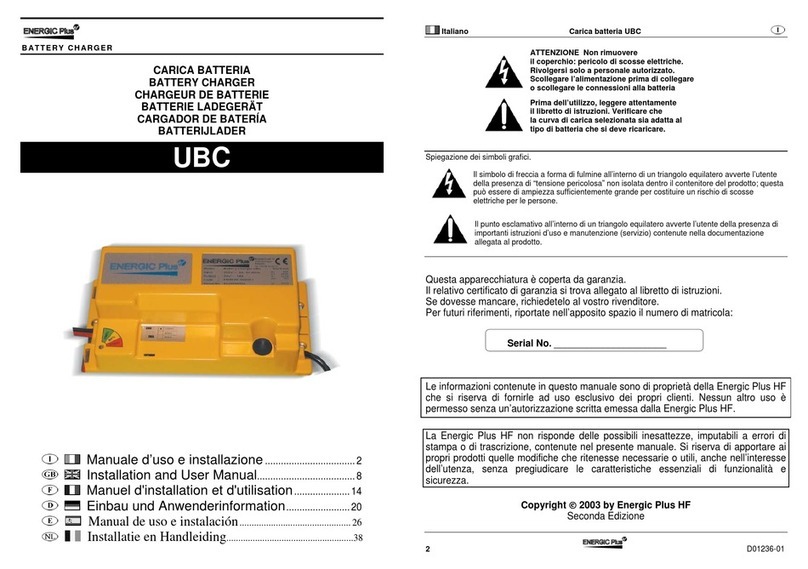Energic Plus LF5 User manual

IN CHARGE OF YOUR BATTERIES
www.energicplus.com
Original
operating
manual
06/2021–
V01
OPERATING MANUAL FOR CUSTOMER
BATTERY CHARGER
LF5 – LF6 – LF7 – LF9

2/44
© 06-2021. Energic Plus is a trademark of TVH Parts Holding NV, Brabantstraat 15, B-8790 Waregem. All rights reserved. No part of this publication may be
reproduced or communicated in any form or by any means, electronic or mechanical, including copying, recording or use in an information storage or
retrieval system, without prior and explicit permission of TVH Parts Holding NV. Printing errors reserved. Photographs and illustrations are included for
reference purposes only.
Responsible editor: TVH Parts Holding NV, Brabantstraat 15, BE-8790Waregem
TVH is a supplier of after-market spare parts and accessories that are suitable for the maintenance and repair of OEM equipment.

3/44
www.tvh.com/LF-charger_RV01
BG Bulgarian Можете да намерите това ръководство на Вашия език чрез линка, посочен по – долу.
CS Czech Tento návod najdete ve svém jazyce prostřednictvím odkazu níže.
DA Danish Du kan finde denne vejledning på dit sprog via nedenstående link.
DE German Sie finden diese Bedienungsanleitung in Ihrer Sprache unter folgendem Link.
EL Greek Μπορείτε να βρείτε αυτό το εγχειρίδιο στη γλώσσα σας μέσω του παρακάτω συνδέσμου.
EN English You can find this manual in your language via below link.
ES Spanish Encontrarás este manual en su propio idioma a través del siguiente enlace.
ET Estonian Oma emakeelse juhendi leiate allolevalt lingilt.
FI Finnish Löydät tämän manuaalin omalla kielelläsi alla olevan linkin takaa.
FR French Vous trouverez ce manuel dans votre langue via le lien ci-dessous.
GA Irish Tá an lámhleabhar seo ar fáil i do theanga tríd an nasc thíos.
HR Croatian Ovaj prirucnik mozete pronaci na svom jeziku putem donjeg linka.
HU Hungarian Ez a kézikönyv az Ön nyelvén az alábbi link alatt található.
IS Icelandic Hægt er að finna þessa handbók á þínu tungumáli á tenglinum hér að neðan.
IT Italian Cliccando sul link sottostante troverai il manuale nella tua lingua.
LT Lithuanian Šį vadovlėlį savo kalba rasite spustelėję žemiau esančią nuorodą.
LV Latvian Rokasgrāmatu latviešu valodā Jūs varat atrast izmantojot zemāk esošo saiti.
MT Maltese Tista’ssib dan il-manwal bil-lingwa tiegħek permezz tal-link ta’hawn taħt.
NL Dutch Je vindt deze handleiding in jouw taal via onderstaande link.
NO Norwegian Du finner denne håndboken på ditt språk via linken nedenfor.
PL Polish Niniejsza instrukcja obsługi dostępna jest wTwoim języku za pośrednictwem poniższego linku.
PT Portuguese Pode encontrar este manual no seu idioma através do link abaixo.
RO Romanian Puteți găsi acest manual în limba dvs. prin link-ul de mai jos.
SK Slovak Manuál vo vašom jazyku môžete nájst v priloženom vysvietenom riadku.
SL Slovenian Ta priročnik najdete v svojem jeziku preko spodnje povezave.
SV Swedish Du kan hitta denna manual på ditt språk via länken nedan.
TR Turkish Bu kılavuzu aşağıdaki bağlantıdan kendi dilinizde bulabilirsiniz.

4/44
Thank you for using our product. For your safety and to ensure a correct operation, we would like to
bring to your attention some aspects of this manual:
• This booklet supplies useful instructions for the correct operation and maintenance of the product.
It is therefore necessary to pay the utmost attention to all of the paragraphs that illustrate the most
simple and secure way to operate and use this product.
• This booklet must be considered an integral part of the machine and must be included with the
deed of sale.
• Neither this publication, nor part of it, can be reproduced without written authorisation on the part
of the manufacturer.
• All of the information reported herein is based on data available at the moment of printing; the
manufacturer reserves the right to carry out modifications to its own products at any moment,
without notice and without incurring in any sanction. It is therefore suggested to always check for
possible updates.
The person responsible for the use of the product must make sure that all of the safety rules in force in
the country of its use are applied, to guarantee that the equipment is used in conformity with the use
for which it is destined and to avoid any dangerous situation for the user.
The following warning signs are used in this manual to warn you for dangers and risks:
Informative, be careful.
Warning, can lead to injury and damage if instructions aren’t followed.
Danger, can lead to serious or fatal injury and serious damage if instructions aren’t
followed.
The following conventions are used in this manual:
1
3
2
6
5
4
1Top
2 Back
3 Right
4 Bottom
5 Front
6Left

5/44
TABLE OF CONTENTS
1. INTRODUCTION...............................................................................................6
2. DESCRIPTION..................................................................................................8
2.1. Technical data......................................................................................................................8
2.2. Main components of the product .......................................................................................10
2.3. Type plate..........................................................................................................................11
3. SAFETY INSTRUCTIONS.................................................................................. 12
3.1. Explanation of the safety decals ..........................................................................................12
3.2. General safety instructions..................................................................................................12
4. TRANSPORT AND STORAGE............................................................................ 14
5. ASSEMBLY AND INSTALLATION....................................................................... 15
5.1. Packing list.........................................................................................................................15
5.2. Safety instructions..............................................................................................................15
5.3. Electrical installation of the charger.....................................................................................15
6. COMMISSIONING........................................................................................... 16
6.1. The front panel...................................................................................................................17
6.2. Connecting the battery to the charger.................................................................................17
6.3. Activate the user program mode.........................................................................................17
6.4. Adjusting a parameter........................................................................................................18
7. OPERATION................................................................................................... 20
7.1. Safety instructions for operating the product.......................................................................20
7.2. Operating instructions. . . . . . . . . . . . . . . . . . . . . . . . . . . . . . . . . . . . . . . . . . . . . . . . . . . . . . . . . . . . . . . . . . . . . . . . . . . . . . . . . . . . . . . . . . . . . . . . . . . . . . . . 20
8. MAINTENANCE.............................................................................................. 23
8.1. Safety instructions for the repair of the product ...................................................................23
8.2. Maintenance schedule .......................................................................................................23
8.3. Maintenance instructions ...................................................................................................23
9. TROUBLESHOOTING ...................................................................................... 24
9.1. Warning signals..................................................................................................................24
9.2. Control board alarms and troubleshooting..........................................................................25
10. TEMPORARILY OUT OF ORDER ........................................................................ 28
11. FINAL DECOMMISSIONING AND DISPOSAL...................................................... 29
12. ANNEXES ...................................................................................................... 30
12.1. CE-certificate .....................................................................................................................30
12.2. Overview per parameter.....................................................................................................38
12.3. Model list...........................................................................................................................41
12.4. Medical and first-aid treatment...........................................................................................43

6/44
1. INTRODUCTION
This manual contains all the necessary information on operation of the Energic Plus LF battery
chargers.The installation, comissioning and some of the maintenance operations should only be
carried out by professional technicians. A separate manual is available especially for the technician to
complete the installation and commissioning.
If you require this information and the maintenance steps, please contact your dealer.
Also included in this manual are a number of safety instructions to create a safe working environment.
The Energic Plus LF battery chargers have been designed to charge Pb batteries. These units can
convert the AC input voltage to a DC voltage at the correct level, in order to charge the battery cells.
Please read the manual thoroughly and observe the safety procedures before putting the unit into
operation. Contact your dealer for any further questions or concerns you may have.
Please read the manual thoroughly and observe the safety procedures before putting the unit into
operation. The operator and all persons who come into contact with the equipment should read it
carefully and regularly and have access to it at all times.
Keep this manual in a safe place for future reference.
Contact your dealer for any further questions or concerns you may have.
We hope you will enjoy working with your LF battery charger.
If you wish to use these LF battery charger in extreme conditions such as extreme heat,
extreme cold, extreme drought, etc. Please contact your dealer to discuss whether this
product is suitable for the activities you wish to undertake with the LF battery charger.
In the annexes of this template (see chapter 12) you can find a section on first aid. Please read
this chapter thoroughly before you start.
When recharging the batteries, make sure that they are in a well-ventilated area, as the
charging process generates hydrogen gas that is explosive in certain concentrations in air (the
flammability or explosive limits are 4.1% to 72% hydrogen in air). The spark-retarding vents
help slow the rate of release of hydrogen, but the escaping hydrogen may form an explosive
atmosphere around the battery if ventilation is poor.

7/44
To protect against shock, have a qualified electrician verify that the equipment is adequately
grounded and learn what terminals and parts are electrically hot.
Do not try to charge other batteries than Pb batteries.
Check the battery type and the recommended type of charger.
The LF battery chargers may be unsafe if adequate maintenance is neglected. Therefore,
adequate maintenance facilities, trained personnel and procedures should be provided.
Maintenance and inspection shall conform to the following practices:
1. A scheduled planned maintenance, lubrication and inspection system should be followed
(see maintenance instructions chapter 8).
2. Only qualified and authorised personnel shall be permitted to maintain, repair, adjust and
inspect the LF battery chargers.
3. Modifications and additions which affect capacity and safe operation shall not be
performed by the customer or user without the manufacturer’s prior written approval.
Capacity, operation and maintenance plates or decals shall be changed accordingly.
4. If modifications are made without written approval of the manufacturer, warranty will no
longer apply.
Any person in charge of putting the machine into operation, the operation itself or the
maintenance of the machine is urged to carefully read and observe the following instructions.
Make sure that the operators of this product are familiar with the safety instructions and follow
all the procedures. Neglecting these instructions can risk injury or death.
We guarantee a long period of trouble free operation if the unit is operated and maintained
correctly.

8/44
2. DESCRIPTION
2.1. Technical data
Always check the type plate for the correct information.
Model LF5
Type Conventional battery charger
Battery type Wet battery
Total width (mm) (A) 242
Total height (mm) (B) 241
Total length (mm) (C) 222
Minimum operating temperature (°C) –5
Maximum operating temperature (°C) 50
Minimum storage temperature (°C) –20
Maximum storage temperature (°C) 60
Relative humidity 75%
Model LF6
Type Conventional battery charger
Battery type Wet battery
Total width (mm) (A) 366
Total height (mm) (B) 295
Total length (mm) (C) 283
Minimum operating temperature (°C) –5
Maximum operating temperature (°C) 50
Minimum storage temperature (°C) -20
Maximum storage temperature (°C) 60
Relative humidity 75%
C
B
A

9/44
Model LF7
Type Conventional battery charger
Battery type Wet battery
Total width (mm) (A) 580
Total height (mm) (B) 355
Total length (mm) (C) 310
Minimum operating temperature (°C) –5
Maximum operating temperature (°C) 50
Minimum storage temperature (°C) –20
Maximum storage temperature (°C) 60
Relative humidity 75%
Model LF9
Type Conventional battery charger
Battery type Wet battery
Total width (mm) (A) 496
Total height (mm) (B) 783
Total length (mm) (C) 304
Minimum operating temperature (°C) –5
Maximum operating temperature (°C) 50
Minimum storage temperature (°C) –20
Maximum storage temperature (°C) 60
Relative humidity 75%
C
B
A

10/44
2.2. Main components of the product
Model LF5
1
4
2
2
2
5
6
3
2
3
1
2
7
2
N° Component
1 Handle
2 Ventilation
3 Decals
4Control panel
5Output cable (positive)
6Output cable (negative)
7Input cable
Model LF6
1
4
2
2
2
5
6
3
2
3
1
2
7
2
N° Component
1 Handle
2 Ventilation
3 Decals
4Control panel
5Output cable (positive)
6Output cable (negative)
7Input cable
Model LF7
11
1
5
2
4
3
1
11
1
6
1
N° Component
1 Ventilation
2Control panel
3 Decals
4Output cable (negative)
5Output cable (positive)
6Input cable
Model LF9
11
1
5
2
4
3
1
11
1
6
1
N° Component
1 Ventilation
2Control panel
3 Decals
4Output cable (negative)
5Output cable (positive)
6Input cable

11/44
2.3. Type plate
110
11
12
98
2
3
4
5
6
7
N° Explanation
1Type of charger
2Specifications on input phase (varies
per device)
3Date of manufacture
4Number of cells/type
5Battery capacity (varies per device)
6Weight of the charger (varies per
device)
7CE label
8Protection class
9 Brand
10 Specifications on output phase
(varies per device)
11 Serial number (varies per device)
12 Manufacturer's address

12/44
3. SAFETY INSTRUCTIONS
3.1. Explanation of the safety decals
If the decals are damaged or missing, please replace them.
Decal Explanation Reference
Read the manual before using the product 166TA7573
This is an electrical device 163TA6970
Be careful when working with electrical equipment 166TA7574
3.2. General safety instructions
• TVH Parts Holding NV cannot envisage each possible circumstance that may result
in danger. Therefore the warnings given in this publication and which appear on the
equipment are not exhaustive.
In the event that equipment, procedures, work methods or working techniques are used
that are not specifically advised by theTVH Parts Holding NV company, it is necessary to
make sure that there is no danger to the operator or other people.
• Electrical equipment must be installed and maintained in accordance with all the applicable
national and local codes. A power disconnect switch must be located near the equipment.
Check the type plate for voltage and phase requirements.
• Never extend the charging lead without prior approval of the manufacturer. Extending the
charging leads without prior approval of the manufacturer may cause incorrect operation of
the charger and will void the warranty.
• Battery chargers can cause injury or death, damage to other equipment or property, if the
user does not strictly observe all safety rules and take precautionary actions.
• Bare conductors or terminals in the output circuit or underground and exposed live
equipment can fatally shock a person.
• Always keep sparks, flames, burning cigarettes and other sources of ignition away from the
battery charging area.

13/44
• Do not touch battery terminals while the equipment is in operation.
• Keep internal parts clean and dry. Dirt and/or moisture can cause insulation failure.
This failure can result in high voltage at the charger output.
• The battery produces very high currents when short-circuited and any metal conductor
that is carrying this current will burn the skin severely if they come into contact.
• Make sure that any kind of jewellery does not come into contact with the battery terminals
or the cell connectors on top of the battery.
• Ensure that the operator or user is not wearing any conductive materials.
• The cables must never be tensioned. Make sure there is always a little slack.
• Battery acid is very corrosive.The operator or persons using the discharger and/or battery
must always wear protective gloves and eye protection.
• We strongly recommend to wear rubber aprons and face protection as well.
• The ventilation system in the room where the batteries are stored should be designed to
provide an adequate amount of fresh air for the number of batteries being charged.
• Do not place tools or anything metallic on top of any battery.
• Make sure the charger is turned OFF before connecting or disconnecting the battery.
The digital display must be completely OFF.
• Do not open the cabinet. Only qualified personnel can open this.

14/44
4. TRANSPORT AND STORAGE
1. Transport
LF5:
These chargers are equipped with a handle on the upper side.
Carry the charger by the handle foreseen or carry the charger with both hands on the bottom side.
LF6:
Determine if the charger is too heavy for you to carry or not.
If you can carry the charger yourself, carry it in an upright position, with both hands on the bottom
side.
If you decide that the charger is too heavy to carry, you can transport it on a cart with wheels. If you
transport it on a cart, make sure that the charger is fastened with a strap.
Don’t tension the strap in such a way that the LED screen and the digital part on the front of
the charger can be damaged.
Transport LF7 and LF9:
The charger should always be wheeled to the work area if possible with a cart or pallet truck.
Make sure the charger is fastened with a strap.
Don’t tension the strap in such a way that the LED screen and the digital part on the front of
the charger can be damaged.
Wheel the charger only across smooth surfaces.
Always transport the charger in an upright position as the centre of gravity must be at the bottom.
Jolting caused by the wheels catching on uneven surfaces can cause physical strain and
personal injury.
2. Storage:
• Do not cover the charger so that it can cool down sufficiently.
• Do not place the charger in a humid area or a place where splashes of any kind of liquid can fall on it.
The relative humidity must be less than 75%
• The charger should be stored in a space between –20 °C and 60 °C. Anything below or above this
temperature will damage the battery charger.
• Keep the charger away from areas where sparks are generated.
• Provide good ventilation to prevent the accumulation of oxyhydrogen.
• Place protection around the charger so that no one can drive into or collide with it.
• Place the charger on an elevated platform of at least 50 cm (19 inch) from the floor. This will prevent
fire caused by dust.
• Place a fire extinguisher close by.
• Install smoke detectors nearby.
• Do not place any objects on the charger.

15/44
5. ASSEMBLY AND INSTALLATION
5.1. Packing list
Description Amount Reference
Charger box 1Check annex 12.3 for
the correct reference or
contact your dealer
Operating manual 1 166TA8672
5.2. Safety instructions
• The charger can be installed by qualified personnel only. Ask your dealer for the technician’s
manual.
• Use correct mating plugs and sockets. Check the grounding conductor for electrical
continuity before using equipment.The grounding conductor must be a size equal to or
larger than the size recommended by code or this manual.
• Check that the unit’s operating voltage is identical to your local mains voltage.
• Check that the unit’s maximum input power is available from your mains voltage.
• To prevent fire or shock hazard, do not expose the unit to rain or moisture.
• Allow for adequate air circulation.
• Do not place the unit near materials that may block the ventilation slots.
• Do not install the unit near heat sources such as radiators or air ducts.
• Do not install the unit in a place subjected to direct sunlight, excessive dust, mechanical
vibrations or shocks.
• Ensure that the charger is placed on a stable foundation.
• Before installing and operating the charger, ensure that all packing material has been
removed from the charger.
• Do not install the charger if you notice that it has been damaged by transport or otherwise.
• Make sure that the charger is installed as instructed in this manual and in accordance with
any applicable national or local norm.
• If you want to install several systems, keep in mind that there must always be a minimum of
36 cm (± 15 inch) between the units.
5.3. Electrical installation of the charger
• Check the efficiency of earth circuitry (yellow/green wire).
• Connect the charger to the mains using adequate plugs, with push buttons and fuses.
• Use an adequate connector to connect the charger to the battery.
Any other settings like AC voltage adjustment and other must be done by qualified personnel
only. For more information, ask your dealer for the technician’s manual.

16/44
6. COMMISSIONING
This charger is designed for charging lead acid automotive batteries only. The charger converts the
AC input into DC, at the correct value to charge the battery.
The charger is only suitable for conventional charging applications.
The standard model of the LF chargers follows the Wa charging curve as described by the DIN 41774
norm.
The charger’s operation is controlled by a microprocessor. A typical charging cycle consists of 3 parts:
• INITIAL or BULK CHARGING
The battery is in a discharged state. The voltage of the battery cells is below the“gas”point
(i.e. approximately 2.40 V/cell at a temperature of 30 °C).
In this condition, the battery can absorb a large amount of energy. The charger operates close to its
maximum power, keeping the battery voltage under control.
• REDUCING or ABSORBERING THE CHARGING
The battery voltage exceeds the“gas”point. The electrolyte produces gas and the charging current
must be reduced to prevent the battery from overheating.The charger adjusts its output current
and finishes charging when it detects a full state of charge (= 100%).
• EQUALISATION
Once charging is complete, the charger automatically stops and allows the battery to cool. If the
battery remains connected to the charger for long enough (e.g. over the weekend), the charger will
emit additional, controlled, low current pulses. The purpose of this process, called“equalization”, is to
bring all the battery cells to exactly the same state of charge.
The battery chargers are equipped with two setting blocks, for selection of the nominal AC input
voltage and better optimization of the charging curve.
NOMINAL VOLTAGE 3-phase and 1-phase
This setting is present on chargers designed to operate with different nominal AC input voltages,
e.g. 3 x 230/400VAC or 1 x 208/240/480 VAC.
Some chargers use a screw-type terminal block for this setting, while others use a standard bar-type
(delta-wye) terminal block.
CHARGING CURVE OPTIMISATION
This setting is present on all LF chargers. Its purpose is to compensate for fluctuations in the AC input
voltage at the installation site.
It is recommended to check the actual value of the available AC input voltage at the installation site,
and adjust the charger output current accordingly.
A screw terminal block is used for this adjustment on all chargers. In the case of single-phase models,
one wire must be routed. On 3-phase models, three wires must be connected.
• Safe practices must be learned through study and training before using this equipment.
• Only qualified personnel should install or service this battery charger.
Before disconnecting the battery, check that it is not being charged. If it is charging, turn off
the charger using the main switch or the stop push button, to avoid sparks between
connectors.
If the RGB LED flashes, the charger is active. Do not disconnect the battery!
Only when the RGB LED shows a SOLID colour (also white) you can disconnect the battery.

17/44
6.1. The front panel
3
4
1
2
N° Explanation
1Red LED for warning and/or alarm
2Multi-coloured LED (RGB) with 8
possible colours
3Push button for equalising
4Push button to stop or restart charger
3
4
1
2
N° Explanation
1Alarm signal
2Contact error messages. Always
combined with another LED. See
chapter 9 for additional expalantion.
3Warning signal
4Status of the battery (possibly
combined with another LED)
6.2. Connecting the battery to the charger.
1. Connect the battery correctly to the charger.
2. The control board is energized and the microprocessor will perform an automatic test of the
control circuits.
3. The“Status”and“Alarm/Warning”LEDs will show a colour sequence that allows the user to
recognize the parameter settings.
6.3. Activate the user program mode.
1. Press and hold the STOP/START button for at least 5 seconds.
2. When the‘WARNING/ALARM’LED illuminates, the charger is in
user program mode.

18/44
6.4. Adjusting a parameter
1. Hold down the EQ button for 1 second.
2. To browse through the parameters, press the STOP/RE-START
button.
3. If the Alarm/Warning LED continues to flash red and the
RGB LED shows different colours (this is to indicate the
programmable parameters) the unit is ready to adjust the
values.
The programmable parameters:
Parameter 1: gassing voltage
Parameter 2: maximum voltage
Parameter 3: equalize mode
Parameter 4: charge mode
A clear overview for each parameter can be found in
Annex 12.2.
Parameters 5 to 8 are intentionally not shown as these
are settings for the technician to adjust.
If you still have questions about these settings or think
you have changed them by mistake, contact your
dealer.
1 3 42
4. If you wish to change a parameter, you must select it by
pressing and holding the EQ button for 3 seconds.
5. Do this until the“Alarm/Warning”LED lights up red
continuously.

19/44
6. Now you can change the value by pressing STOP/RE-START.
Press and hold for 1 second.
The“Alarm/Warning”LED turns solid red and the RGB LED
lights up:
• Blank/empty: value n° 1
• Red: value n° 2
• White: value n° 3
• Blue: value n° 4
• Yellow: value n° 5
• Purple: value n° 6
If you wish to save the changed parameter, press and hold the EQ button for 3 seconds until the‘Alarm/Warning’
LED starts flashing red again. At that moment the new parameter is stored in the memory.
If you wish to return to the start menu, press the STOP/RE-START button for 5 seconds.
If the RGB LED flashes, the charger is active. Do not disconnect the battery!
Only when the RGB LED shows a SOLID colour (also white) you can disconnect the battery.

20/44
7. OPERATION
7.1. Safety instructions for operating the product
• A damaged or malfunctioning machine must never be used. If damage or malfunctions are
discovered during daily maintenance check or function tests, the machine must be tagged
and removed from service.
• Battery chargers can cause injury or death, damage to other equipment or property, if the
user does not strictly observe all safety rules and take precautionary actions.
• Bare conductors or terminals in the output circuit or underground and exposed live
equipment can fatally shock a person.
• Do not work in a damp area without being extremely careful.
• Stand on a dry rubber mat or dry wood.
• Use insulating gloves when dampness or sweat cannot be avoided.
• Keep clothing dry.
• Use leads that have sufficient capacity to carry the operating current without overheating.
• Always keep sparks, flames, burning cigarettes and other sources of ignition away from the
battery charging area.
• Do not break‘live’circuits at the battery terminals.
• Make sure the charger is turned OFF before connecting or disconnecting the battery.
The digital display must be completely OFF.
• Make sure that the operating temperature is between 5 °C and 45 °C.
• Make sure that the relative humidity is less than 75%.
• Do not use the unit in presence of flammable gas.
• Do not open the cabinet. Only qualified personnel can open this.
• Survey the operation when the battery must remain connected to the charger for more
than 12 hours.
If the RGB LED flashes, the charger is active. Do not disconnect the battery!
Only when the RGB LED shows a SOLID colour (also white) you can disconnect the battery.
7. 2 . Operating instructions
Please see Chapter 8 for the daily maintenance schedule.
Using the charger with the battery
As soon as the battery is connected, the control board turns
on. If the battery and the AC input are correctly connected, the
charging cycle starts automatically.
Depending on the internal settings, the DC charging current
follows the programmed curve.
If the output of the charger is active and a DC output current is
present, the RGB LED flashes.
As previously explained in the commissioning section, the charger
works in phases. A different colour will appear depending on
which phase the unit is in.
This manual suits for next models
3
Table of contents
Other Energic Plus Batteries Charger manuals

Energic Plus
Energic Plus RX User manual
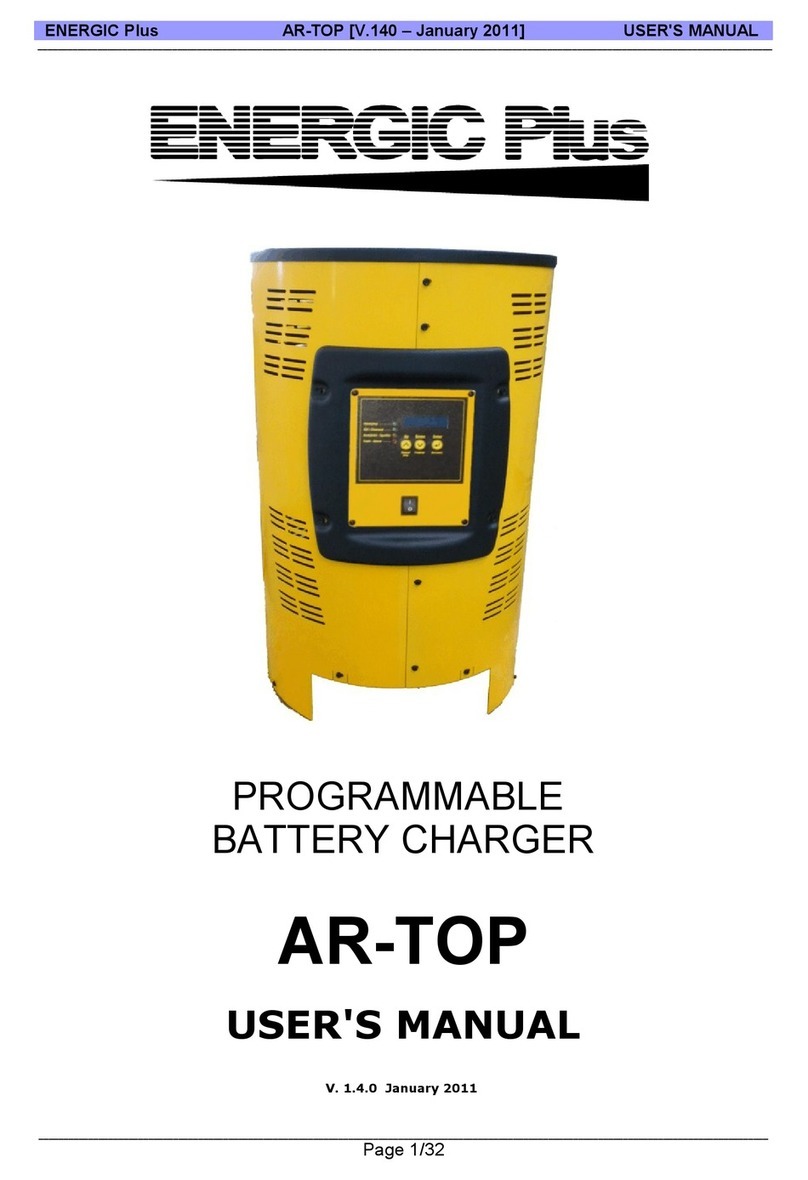
Energic Plus
Energic Plus AR-TOP User manual
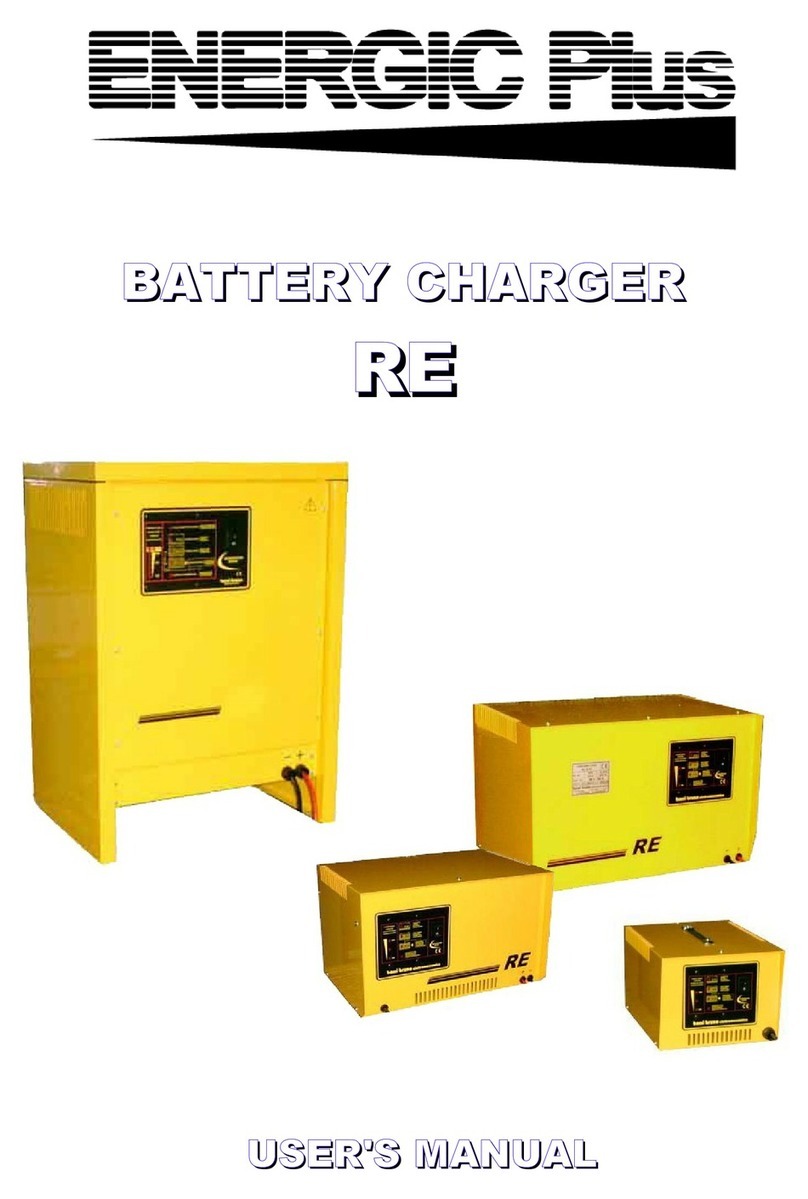
Energic Plus
Energic Plus RE Series User manual
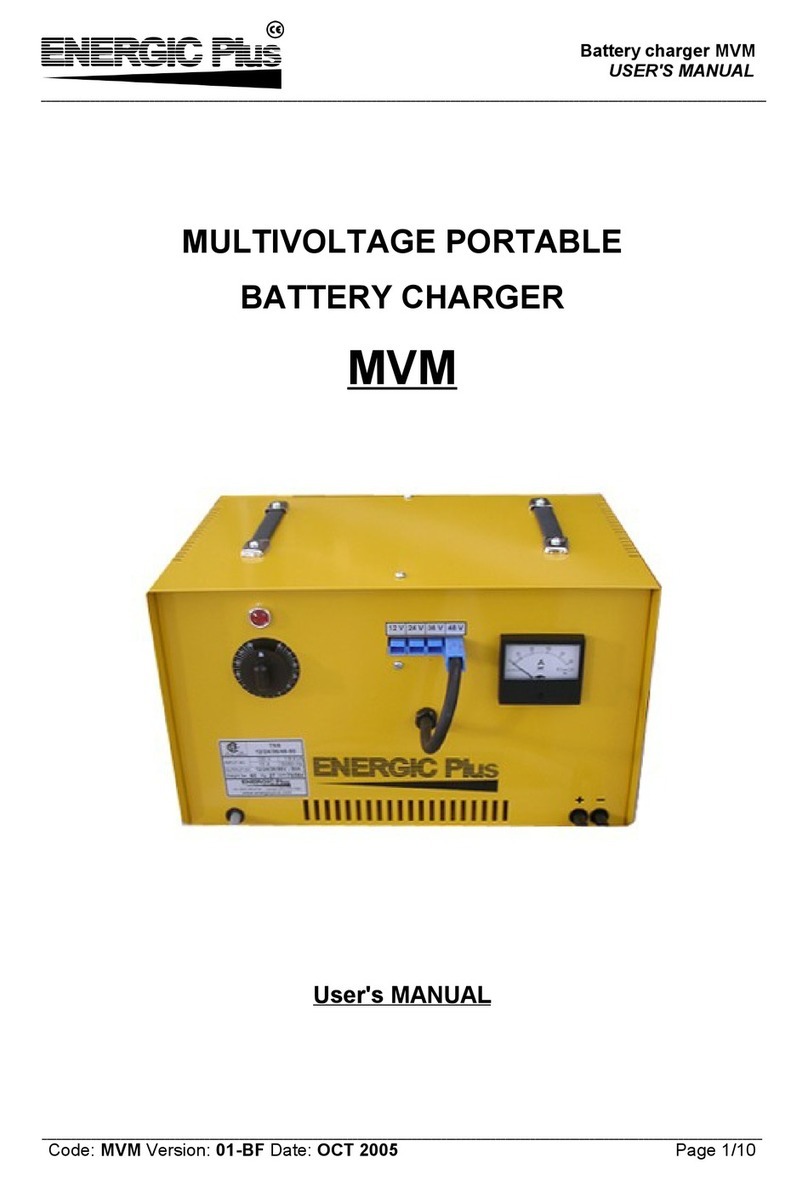
Energic Plus
Energic Plus MVM User manual

Energic Plus
Energic Plus 124TA1705 User manual
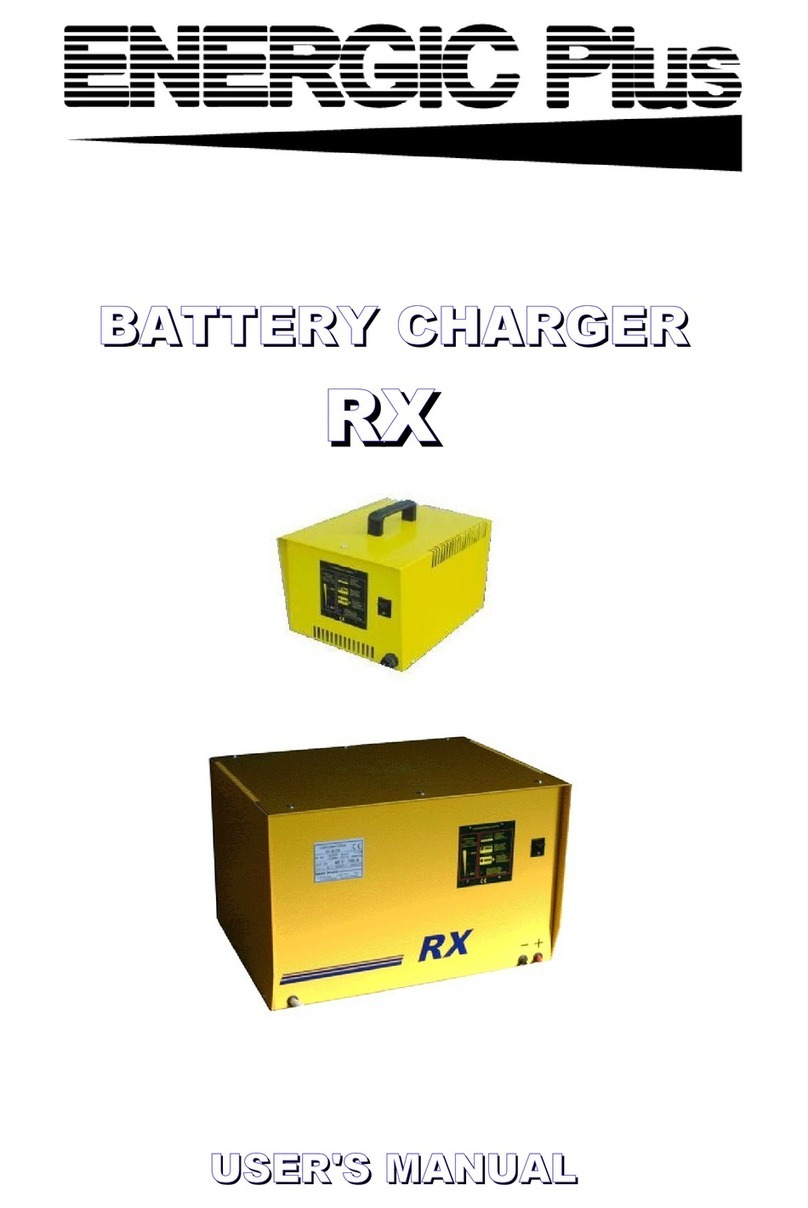
Energic Plus
Energic Plus RX User manual
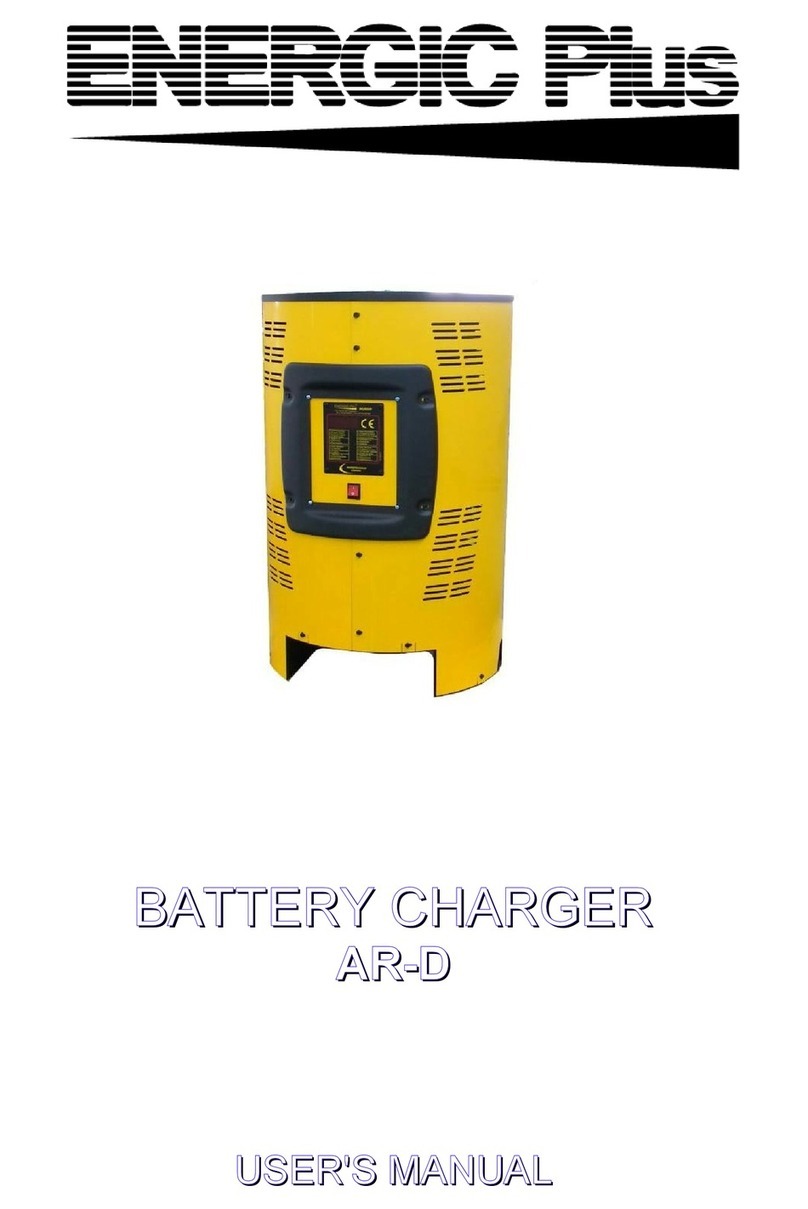
Energic Plus
Energic Plus AR-D User manual
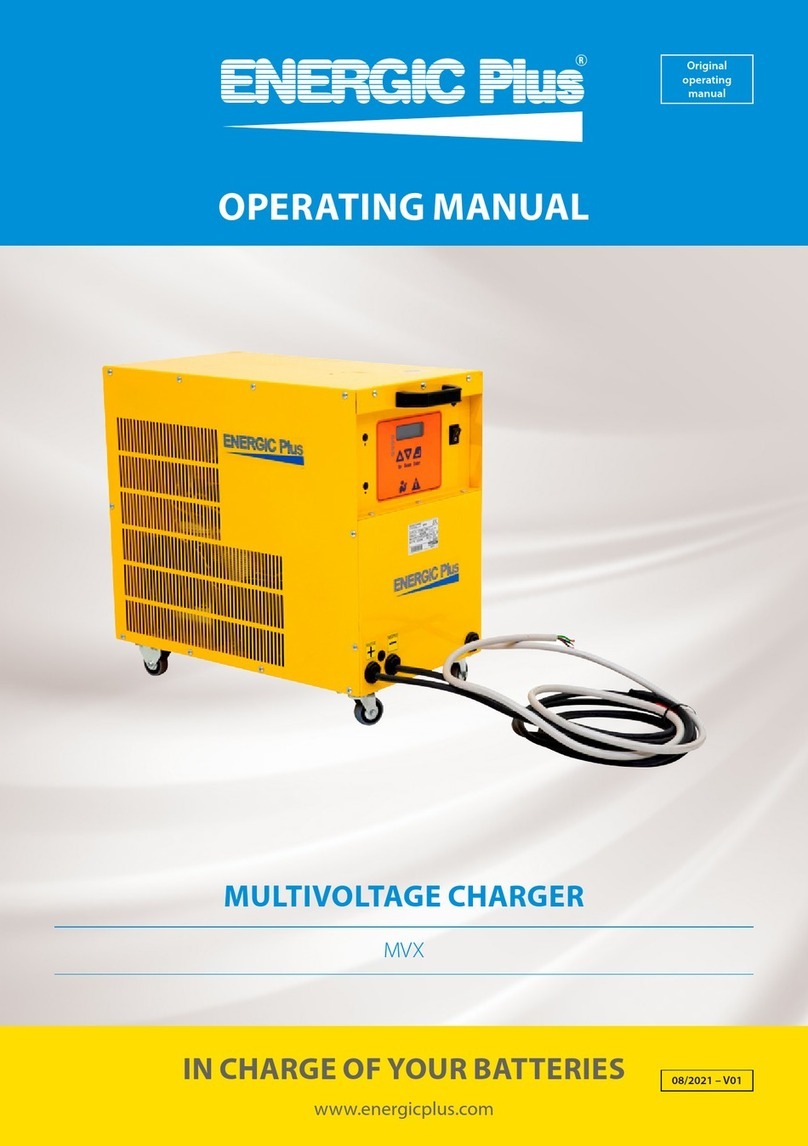
Energic Plus
Energic Plus MVX User manual
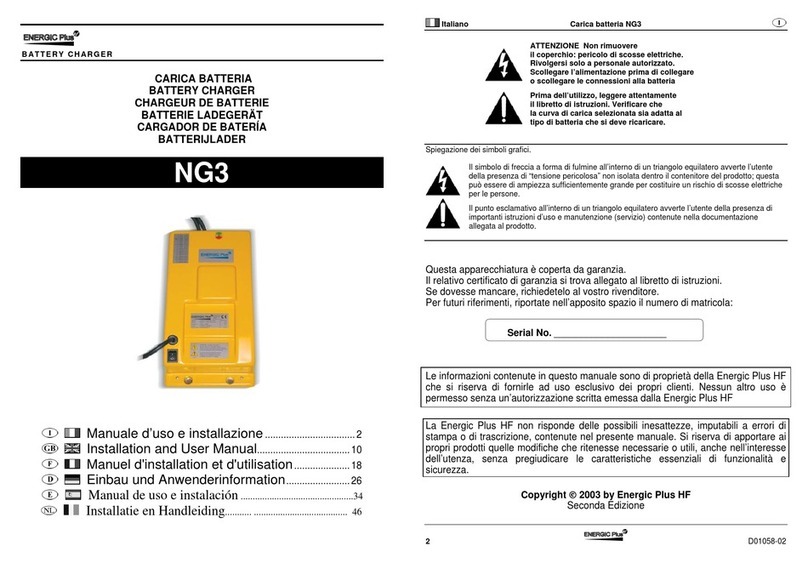
Energic Plus
Energic Plus NG3 User manual
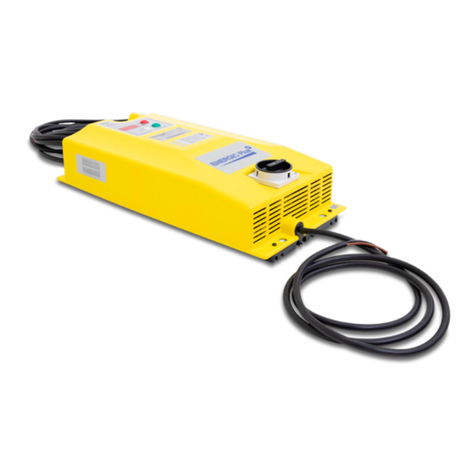
Energic Plus
Energic Plus NG1 User manual
